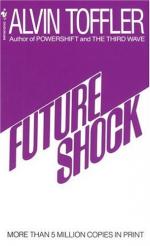
|
| Name: _________________________ | Period: ___________________ |
This test consists of 15 multiple choice questions and 5 short answer questions.
Multiple Choice Questions
1. What does Toffler call the decision to change lifestyle?
(a) A life-or-death decision.
(b) A super-decision.
(c) The malady of transience.
(d) An important decision.
2. Where does the process of preparing for the future begin, according to Toffler?
(a) With adulthood.
(b) With examining one's own reactions.
(c) With marriage.
(d) With acquiring an education.
3. What can people develop to mitigate future shock?
(a) Future shock absorbers.
(b) Future shock buffers.
(c) Future shock intuition.
(d) Future shock dampeners.
4. What would one benefit of government involvement in change management be?
(a) Harnessing more profit from each change.
(b) Measuring the long-term effects of change.
(c) Eliminating future problems.
(d) Distributing the wealth more equitably.
5. What does Toffler say continual change causes?
(a) The suppressive reaction.
(b) The orientation response.
(c) The adaptive reaction.
(d) The aggression reaction.
6. What does Toffler say is the problem with technocrats?
(a) They are self-interested.
(b) They are myopic.
(c) They react slowly to new technologies.
(d) They are limited by their data.
7. What is the result of too much change?
(a) Aggression.
(b) Anorexia.
(c) Manic depression.
(d) Lethargy and apathy.
8. How does Toffler describe a person's choices in the future?
(a) Limited.
(b) Eliminated.
(c) Compelled.
(d) Abundant.
9. What is affected when a person's life changes?
(a) Their immune system.
(b) Their coping mechanisms.
(c) Their psychological adjustment.
(d) Their digestion.
10. What is technology based on in the West, in Toffler's account?
(a) Cost-benefit calculation.
(b) Profit.
(c) Efficiency.
(d) The common good.
11. What does Toffler say the future will do to people?
(a) Change their genetic structure.
(b) Provide for unprecedented numbers of satisfied people.
(c) Reinvent the laws of society.
(d) Push them toward the top of the adaptive range.
12. How will new technologies help people, in Toffler's opinion?
(a) They will increase adaptability.
(b) They will numb people to changes.
(c) They will reduce the impact of changes.
(d) They will capitalize on change.
13. What is the method people use to cope with future shock?
(a) They limit the information they take in.
(b) They acquire behavioral tics.
(c) They cling to their families.
(d) They repress any unpleasant experiences.
14. Why were alternative schools formed, in Toffler's account?
(a) To combat the standardization of education.
(b) To make schools for all girls or all boys.
(c) To provide for religious education.
(d) To provide people with cheaper education options.
15. What will happen if preventative steps are not taken, in Toffler's account?
(a) Society will be striated by class.
(b) Society will collapse.
(c) People with power will rule unchecked.
(d) Culture will be ruined.
Short Answer Questions
1. What do subgroups provide for people?
2. What effect does an increasing rate of change have on the differences between age groups?
3. What does Toffler call modern people who live in tropical climates?
4. What is it that affects a person who is undergoing change?
5. How does Toffler say can we prevent future shock?
|
This section contains 497 words (approx. 2 pages at 300 words per page) |

|




